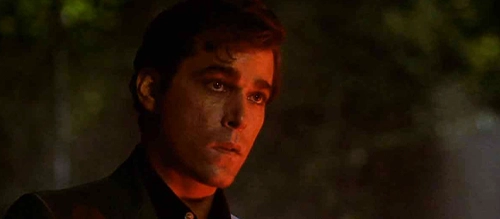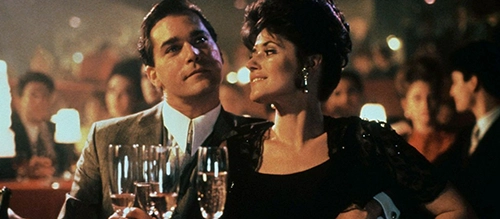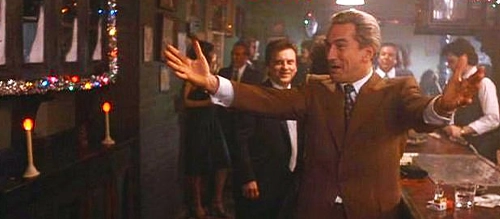Scorsese’s Goodfellas and The Power of Movie Soundtracks
We’ve all been walking along and listening to music, imagining our lives as a movie. The beat kicks in and we’re there: walking into the ring with “Gonna Fly Now”, leaping into Patrick Swayze’s arms with “(I’ve Had) The Time of My Life” and chopping off the ear of a policeman to the sound of “Stuck in the Middle with You.” Okay, maybe not that last one, but you could say that as far back as we can remember, we’ve always wanted to be a movie star.
Some of the most famous movie scenes of all time feature originally composed music or lift pieces from older films and recontextualise them for a modern audience, such as Tarantino pinching all of Ennio Morricone’s back catalogue. But what happens when you abandon this approach in favour of utilising a soundtrack of pre-released popular songs? It’s an idea that has been utilised as a directorial trademark by the likes of Quentin Tarantino and Edgar Wright, but it is widely acknowledged to have been popularised in western cinema by Easy Rider (1969) and specifically the films of Martin Scorsese. The latter has many a trademarked needle drop in his repertoire, but his use of soundtrack was arguably at its height in his 1990 gangster thriller Goodfellas.
In Goodfellas, the meticulously chosen selection of 50s to 70s music plays a huge hand in creating the memorable moments that have stayed with us (and reached new audiences) across the past thirty-plus years. In an interview with Esquire, the film’s music editor Chris Brooks claimed that Scorsese “[…] knew every one of those songs two years before he shot a frame of film.” It clearly paid off…

Although primarily told in chronological order, Goodfellas opens in media res, with the three central protagonists – Henry Hill (Ray Liotta), Jimmy Conway (Robert De Niro) and Tommy DeVito (Joe Pesci) – driving to dispose of a body in 1970. During the sequence, they realise the man is not dead, so they brutally murder him. After the job is done, Henry delivers the legendary opening line of “as far back as I can remember, I always wanted to be a gangster” and slams the car boot down. This is where we hear the first needle-drop: the late, great Tony Bennett’s “Rags to Riches”.
The lively brass selection that creates the opening of the song submerges us into the glamorous lifestyle of the gangster, allowing us to gaze with Henry’s childlike wonder at these powerful mobsters, making us forget about the brutality we just witnessed in the opening scene. As we are transported back to 1953, the lyrics of the song, coupled with the richness of Bennett’s voice, establish the running theme of the film: the ascent to, and descent from, power.
Through the use of doo-wop and crooner tunes popularised in the 1950s, we see Henry’s journey from a bullied neighbourhood kid into a fully-fledged mob associate.
Despite the flashy violence often seen in his films, Scorsese is an auteur renowned for authenticity, whether that be capturing Tibetan spiritual leaders, Gilded Age high society or Jesus Christ himself. When it came to Goodfellas, Henry’s upbringing mirrored Scorsese’s own in 1950s Italian-American neighbourhoods in New York. Therefore, the sequences of Henry’s childhood were soundtracked to Italian-language songs, reflecting the tradition and values set by the mobsters that Scorsese himself would have encountered.
The jump-cut to adult Henry takes us to 1967, significant in both the film’s timeline and the progression of music. In the 60s, music producer Phil Spector pioneered what is known as the Wall of Sound technique, where he would utilise studio recordings to make rich, orchestral tones that were designed to be played on jukeboxes and radios. With that, Spector used his formula to popularise several girl groups, including The Crystals.
In Goodfellas, Henry has seamlessly adjusted into his glamorous gangster lifestyle and his new challenge is his relationship with Karen Friedman (Lorraine Bracco). Whilst he was originally disinterested in her, her fiery attitude and “great eyes like Liz Taylor’s” prompted him to take her on a date to the notable Copacabana club. To emphasise his importance in the mafia world, Henry takes Karen through the back door of the club and through the kitchens before the waiter miraculously produces a table out of thin air for them to sit right next to the stage. This sequence is shot in an unbroken long take and accompanied by The Crystals’ “Then He Kissed Me”. It is a sweet and romantic song, where context reflects that both the music and Henry are in a new stage of life.

This new stage of life culminates with Henry and Karen’s wedding montage, as The Harptones’ dreamy “Life is But a Dream” plays throughout. The Harptones were a fairly unsuccessful group, never breaking into the top forty, but their song is the perfect choice for how Henry and Karen’s lifestyle was too good to be true.
From this point, we rattle through Henry’s day-to-day mobster business, reflected through the use of more of the same doo-wop, adult standard tunes. Significant hits being Dean Martin’s “Ain’t That a Kick in the Head” (a song originally written to be in the 1960 version of Ocean’s 11) and Queen of Soul Aretha Franklin’s “Baby I Love You”. Even when Henry and his associates are arrested, the breeziness of prison life for a gangster is reflected by “Beyond the Sea” by Bobby Darin. The singer’s voice is as cool as you like.
When Henry takes a turn for the worse, however, the soundtrack keeps up with him. During his time in prison, Henry becomes mixed up in the drug trade. We see him snorting cocaine with his new girlfriend Sandy at her apartment, soundtracked by the Scorsese Staple “Gimme Shelter” by The Rolling Stones. Used again in his films Casino and The Departed (twice in the latter), the brutal anti-war ballad is a stark contrast to the easy-listening previously heard within Goodfellas, signifying how Henry has strayed from his original path of gangster to dealer.

What was there from the 60s and 70s still remains, but only just. Christmas tunes from Spector’s acts The Ronettes and Darlene Love play when the mafia are celebrating their Lufthansa heist victory. However, the joy is short lived for all three protagonists: Tommy is murdered to the sound of the piano exit from Derek and the Dominoes’ “Layla”, and Jimmy silently decides to murder all of his crew to the sound of Cream’s “Sunshine of Your Love”. These iconic rock songs accompany pivotal and iconic scenes in the film, and all incidentally feature Eric Clapton, whose career spanned from the 60s and into the 70s. When filming, Scorsese played “Layla” on-set to synchronise the staging, blocking and camera movement with the instrumentals.
The climax of the film sees us hurtling into the 80s, as Henry has the day from Hell trying to juggle his family life, gangster life and drug-dealing life, until it all blows up in his face. The sequences from the chaotic day are amplified in tension by the use of high-octane songs from rock legends Harry Nilsson, The Rolling Stones, The Who, George Harrison, and Muddy Waters. The glamour is gone, Henry’s life is over; rock n’ roll is here to stay.
And so, that leaves us with the final song. The last shot sees Henry living as a ‘schnook’. Stuck in witness protection to save his own skin, Henry laments that everything he worked for was for nothing and that he is confined to living a boring, meaningless existence. Scorsese chooses to close the film with Sid Vicious’ cover of Frank Sinatra’s “My Way”. This is a spectacular song choice to end the film with as it is an imitation of a legendary crooner song associated with glamour and elegance, performed by an artist known for his notoriety and vulgarity. In the end, Henry becomes Sid Vicious, the outcast, desperately longing for the glamour that Frank Sinatra had.
The Goodfellas soundtrack is one for the ages. It illustrated how Martin Scorsese’s careful crafting of a soundtrack comprised of pre-released songs can elevate plot points, convey narrative changes, reinforce or signal developments to themes, and add a great deal of authenticity to a film’s world.
Alexa, play “Gimme Shelter”.
Written by Grace Laidler
Follow Grace Laidler on Twitter: @gracewillhuntin

